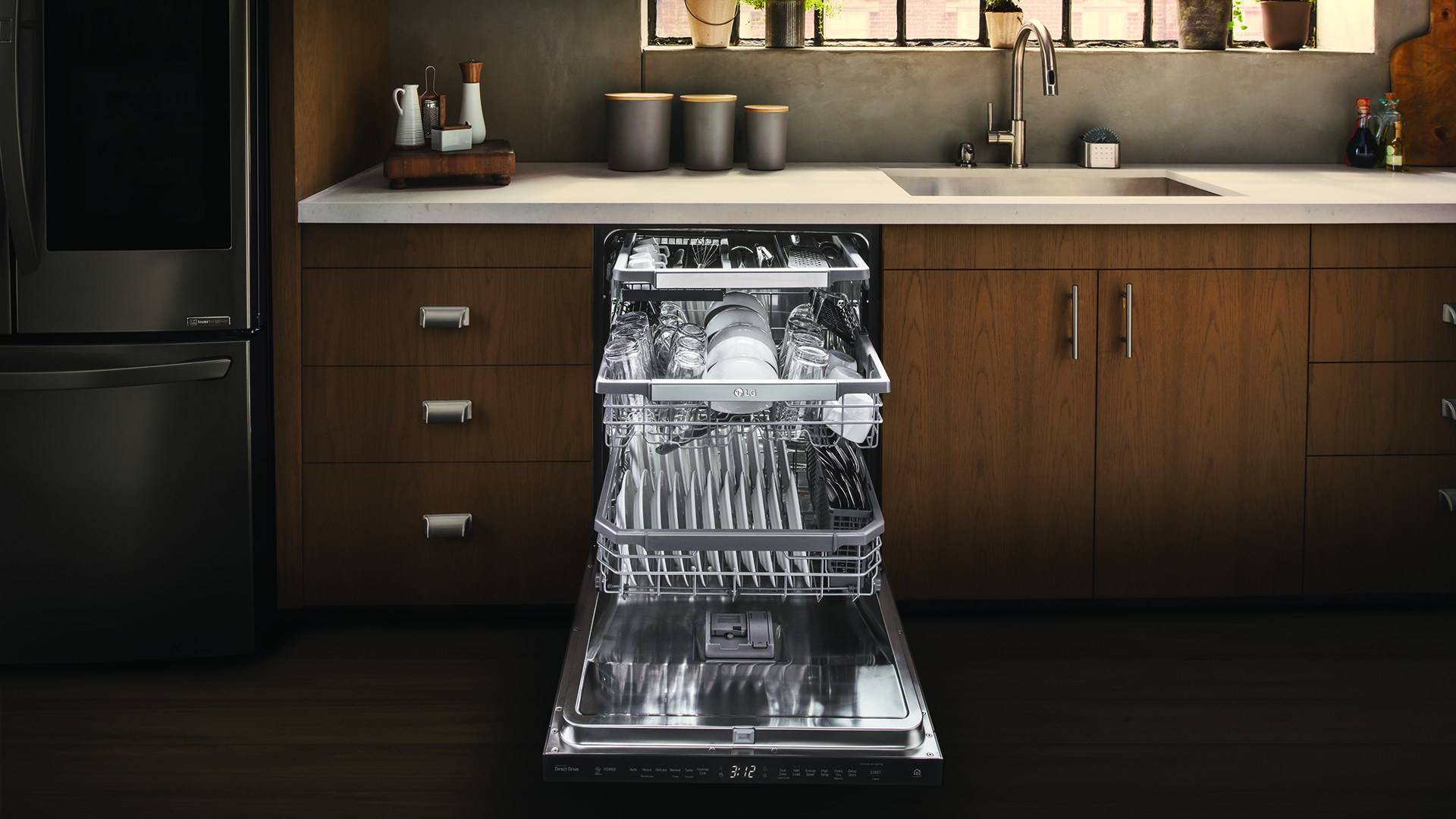Why is my cutlery going rusty in the dishwasher? Here's how to fix the problem
Noticing new rust spots on my cutlery after each dishwasher cycle? Try these techniques.

After years of living in small flats with even smaller kitchens, I could wax poetic about the endless joys of having a dishwasher now that I finally live somewhere big enough to house one. I genuinely couldn’t imagine returning to a life where I had to shimmy into the washing-up gloves every evening. I was so frustrated when I realized that my dishwasher was doing more harm than good to my cutlery.
For a few months, I’d noticed minor reddish-brown marks on my plates and mugs after they’d finished going through a cycle in one of the best dishwashers. I was confused and couldn’t figure out why this was happening. In true-to-form fashion, I mentally shrugged and decided not to worry about it unless it got worse (spoiler alert – it did).
As I was putting away newly washed cutlery this weekend, I noticed a small nick in the facade of one of my forks, and rust was forming around it. Immediately perturbed, I examined my cutlery closely and quickly realized that almost half of my knives, forks, and spoons were similarly afflicted. In a total coin-drop moment, I also learned that the red-brown spots on my crockery must have been caused by spots of rust being washed around the dishwasher during a cycle.
While ingesting small amounts of rust ordinarily won’t affect your health, using rusty cutlery in the long term is not a good idea. I reluctantly threw out my old cutlery and bought an entirely new set. However, replacing my cutlery didn’t fix the root cause of the problem – why was my dishwasher making my cutlery rust in the first place?
I consulted David Palmer, LG’s Senior Product Specialist of Home Appliances, who said, “Metals can begin to rust when they come into contact with oxygen or water. This natural chemical reaction does not mean your appliance is faulty. Salty and acidic water can further speed up corrosion, causing your cutlery to rust quickly.
Combining grease, moisture, and heat for prolonged periods inside your dishwasher can also cause corrosion on stainless steel. Leaving your dishwasher closed after a cycle will keep residual steam in the appliance, which will cool and condense on items, leaving them damp for more extended periods."
3 ways I stopped cutlery rusting in my dishwasher
1. I used a hotter wash cycle
Sign up to receive the latest news, reviews, buying guides and deals direct to your inbox
As we all know, metal + water = rust, so I quickly realized that the core problem I was facing was that my cutlery was being exposed to water for too long through my dishwasher, not drying properly. To be more environmentally friendly, I’ve always used my dishwasher’s Eco setting, which washes at roughly 144ºF. However, one of the ways that a dishwasher dries effectively is through getting hot so that the water evaporates.
Using the lower-temperature Eco setting might have prevented my dishes from drying effectively. Instead, I switched to the 160ºF Intensive setting and instantly noticed a difference. When I previously opened my dishwasher after a cycle, most of my dishes would still be wet, especially on the top shelf, where the bowls and mugs usually reside. However, the Intensive setting means that most of my dishes are bone-dry at the end of the cycle.
However, it's worth noting the Eco setting is necessarily something to avoid. David Palmer says, "If washing a full load, the eco cycle is always the most effective, though it may take slightly longer. The slower heating of water and longer cycle means the wash has same effectiveness with less water and energy." The issue with my dishwasher's Eco setting was the comparatively lower temperature of the water, not the length of time it was washing for.
2. I changed the time of day I’d use the dishwasher
My regular dishwasher routine was slowly loading it up throughout the day and then putting it on just before bed. This meant that I would wake up to squeaky-clean dishes, and I wouldn’t have to listen to the sloshing of the wash cycle either – win. However, to ensure that my dishes and cutlery weren’t sitting in water for too long, I changed my routine to turn on my dishwasher in the morning instead.
This means I can put away my dishes and cutlery as soon as the cycle is finished rather than letting them sit in the water all night. Initially, I thought this new routine would be an annoying inconvenience, but it’s been a surprisingly seamless transition.
3. I manually opened the dishwasher door after its cycle
While I’ve been trying to put away my dishes as soon as the dishwasher has finished, sometimes I’m in the middle of a task (or I’m just lazy!). However, one way to help prevent water from collecting on your dishes is to slightly open the dishwasher door once its cycle is finished. This will help circulate air around the dishwasher, preventing condensed water from settling back on your dishes.
However, it’s important to note that you shouldn’t open your dishwasher door too early, as the drying process won’t be over yet. This means that you could make more water settle on your dishes! I usually wait until the dishwasher cycle has fully ended before I open the door.
David Palmer adds, "Moisture is the number one cause of rust. As mentioned above, the air inside your dishwasher is humid after a wash; therefore, it is beneficial for users to open the door a couple of minutes after the cycle ends to let the humid air escape, or if you can’t unload straight away, take out the wet cutlery to assist with the drying."
It should be noted that some dishwashers have features that automatically open the door when the cycle ends so that you don't have to do it manually, but my own isn’t as fancy! However, David Palmer says that LG's Auto Open Dry feature "allows steam to escape the dishwasher cavity, enhancing drying performance. At the end of the cycle the products with this feature will open the door by 8°, it will only do this once the internal tub temperature is 50°C to avoid any scolding."
5 other dishwasher drying tips
While the tactics I used worked well for me, you can still do more to ensure that your dishes are perfectly dry by the time you unload your dishwasher. David Palmer from LG has provided five top tips to help you get the best possible results at the end of every cycle.

David Palmer is the Senior Product Specialist of Home Appliances at LG Electronics, giving a unique insight into how we can all make the most out of our home appliances.
1. Avoid washing non-dishwasher-safe or corroded kitchenware
Not all metals are dishwasher safe. In addition, low-quality metal or metal-coated items are prone to rusting if washed in the dishwasher.
LG’s large capacity and EasyRack™ plus feature allow you to adjust the rack's height levels and flexible tines to accommodate all types of kitchenware. However, although knives tend to be made of more rigid steel, which gives them a lasting edge, they are also more likely to rust from repeated washing in a dishwasher, so it’s best to hand wash these items.
LG recommends avoiding sharp knives in your machine if you have invested in expensive ones. Dishwasher detergent is abrasive, so it can dull the knife. It can also hit other items, further damaging the blade. Ceramic knives, which are more brittle, should also not go in dishwashers.
Rust can spread between metal utensils. So, to protect your other metalware, don’t put rusty items in the dishwasher.
2. Consider your stacking style
Make sure your dishes are correctly loaded and don’t touch each other. Overpacking the cutlery basket can result in staining. The LG QuadWash™ Dishwasher's top rack includes a cutlery tray so items won’t touch each other. Stainless steel and silver-plated or copper items mustn't come into contact, as the chemical reaction with hot water and dishwashing detergent can cause discoloration.
For many dishwashers, the sprayer arm works from the middle out, so you want your load to face the middle of the machine to ensure it gets the proper spray treatment required. However, with four-arm appliances (instead of two) now available with LG’s latest QuadWash™ Dishwasher, you have flexibility in your loading as multi-directional rotation cleans from every angle. Just make sure not to obstruct the arms!
3. Avoid using inappropriate detergent or spilling salt
The common mistake we tend to make is using too much detergent. Not only does this cost us money, but it can scratch dishes or result in cloudy glasses or visible spots – a common pain many tend to encounter.
A simple hack involves placing a bowl of vinegar on the top rack before a cycle, which acts as a rinse aid and combats water staining. However, in LG’s new range, the QuadWash™ feature will ensure an effective wash as TrueSteam™ technology emits high-temperature steam to clean thoroughly and reduce undesirable water spots, eliminating these problems from arising and giving your glasses an extra shine.
Be sure to use detergents, rinse aid, and dishwasher salt specifically for dishwashers. Dishwasher salt corrodes metal surfaces, and salt inside the tub may scratch glassware.
Users can even run a prewash program or the shortest program to wash away any salt that may have been spilled inside the appliance. With LG’s range, the salt reservoir screws on, and the rinse aid clicks shut to prevent spilling. Just be careful not to pour any dishwasher detergent directly onto cutlery.
4. Scrape off salty solids
Although scraping off bits of food, particularly salty solids, is essential, we recommend not rinsing dishes before putting them in the dishwasher, as this often makes the soap less effective. However, if you’re not running your appliance for a while, cutlery may be an exception to this rule.
But for plates that need an extra-powerful spray, LG’s Dual Wash features enable you to wash at different intensities on the top and bottom racks.
5. Clean your dishwasher
You’d think dishwashers would be inherently clean, but over time, they often collect food debris, soap residue, and gunk that needs to be wiped away.
Inside your appliance, dishes are sprayed and sterilized with hot steam to eliminate 99.999% of bacteria and viruses. However, cleaning your appliance is essential, and LG recommends doing a tub cleaning every 30 cycles to ensure your dishwasher can perform to the best of its ability.

Louise is the former Editor of Top Ten Reviews. With six years of editorial experience across print and digital brands, Louise has written for a variety of publications, including TechRadar and The Independent. When she's not checking comma placements and finding the best brands for Top Ten Reviews readers, you can either find Louise exploring the countryside with her camera or teaching her border collie fun new tricks.
